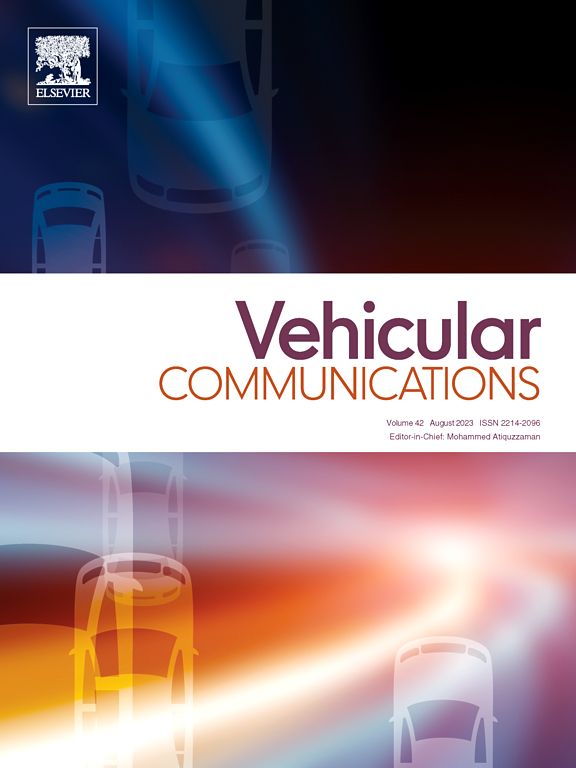可扩展的人工智能驱动的基于意图的车辆到一切通信,用于安全、低延迟和节能的智能城市
IF 6.5
2区 计算机科学
Q1 TELECOMMUNICATIONS
引用次数: 0
摘要
物联网(IoT)和车对车(V2V)通信技术正在快速发展,智能、高效、可扩展的通信框架可以实现最佳资源分配和网络性能目标。鉴于此,尽管在通过物联网实现V2V通信方面取得了重大进展,但目前在密集交通(1500辆/小时)的城市部署中,平均数据包延迟≥120ms,每数据包能耗≥100j,阻碍了生命关键安全应用。为了解决这些限制,我们引入了一种新的四层V2X框架,即ai集成的基于意图的网络(AI-IBN),即:1。通过深度强化学习控制器将高级安全和流意图抽象到主动的每链路策略中。将车对车(V2V)/车对基础设施(V2I)/车对行人(V2P)/车对网络(V2N)的通信集成在一个单一的意图管理器中。提出了基于随机梯度更新、在线优化交叉口时间和公交车道分配的新子问题;and4。使用轻量级和对称密钥身份验证协议以端到端方式加密所有意图。在Python中的谷歌Colab生成的城市交通数据集(2 km2网格,1500 veh / h)中,AI-IBN将平均数据包延迟从150 ms降低到50 ms(67%),将每条消息的能量从150 J降低到50 J(67%),并将数据包成功率从0.65提高到0.93。在特定强度的干扰攻击中(我们已经干扰了10%的信道),我们的安全模块保持了0.90的成功率,而基线低于0.70。这些结果可实现低于50ms和50j的碰撞避免警报,并为集成智能交通系统中可扩展的、关键生命的V2X安全服务奠定了基础。本文章由计算机程序翻译,如有差异,请以英文原文为准。
Scalable AI-driven intent-based vehicle-to-everything communications for secure, low-latency, and energy-efficient smart cities
The Internet of Things (IoT) and vehicle-to-vehicle (V2V) communication technologies are rapidly growing, and a smart, efficient, and scalable communication framework could accomplish the optimum resource allocation and network performance objective. In view of this, although significant progress has been made in terms of V2V communication through IoT, current urban deployments through dense traffic (> 1,500 vehicles / hour experience average packet latencies ≥120 ms and per-packet energy consumptions ≥100 J, precluding life critical safety applications. To address these constraints, we introduce a novel four-layer V2X framework, AI-integrated Intent-Based Networking (AI-IBN), that:
- 1.Abstracts high-level safety and flow intents into the active per-link policies by way of a Deep Reinforcement-Learning controller.
- 2.Integrates vehicle-to-vehicle(V2V)/vehicle-to-infrastructure (V2I)/vehicle-to-pedestrian (V2P)/vehicle-to-network (V2N) communication in a single intention manager.
- 3.Formulates new subproblems that optimize intersection timing and allocate bus-lanes based, online, and with stochastic gradient updates; and
- 4.Encrypts all intents in an end-to-end manner with a lightweight and symmetric-key authentication protocol.
求助全文
通过发布文献求助,成功后即可免费获取论文全文。
去求助
来源期刊

Vehicular Communications
Engineering-Electrical and Electronic Engineering
CiteScore
12.70
自引率
10.40%
发文量
88
审稿时长
62 days
期刊介绍:
Vehicular communications is a growing area of communications between vehicles and including roadside communication infrastructure. Advances in wireless communications are making possible sharing of information through real time communications between vehicles and infrastructure. This has led to applications to increase safety of vehicles and communication between passengers and the Internet. Standardization efforts on vehicular communication are also underway to make vehicular transportation safer, greener and easier.
The aim of the journal is to publish high quality peer–reviewed papers in the area of vehicular communications. The scope encompasses all types of communications involving vehicles, including vehicle–to–vehicle and vehicle–to–infrastructure. The scope includes (but not limited to) the following topics related to vehicular communications:
Vehicle to vehicle and vehicle to infrastructure communications
Channel modelling, modulating and coding
Congestion Control and scalability issues
Protocol design, testing and verification
Routing in vehicular networks
Security issues and countermeasures
Deployment and field testing
Reducing energy consumption and enhancing safety of vehicles
Wireless in–car networks
Data collection and dissemination methods
Mobility and handover issues
Safety and driver assistance applications
UAV
Underwater communications
Autonomous cooperative driving
Social networks
Internet of vehicles
Standardization of protocols.
 求助内容:
求助内容: 应助结果提醒方式:
应助结果提醒方式:


